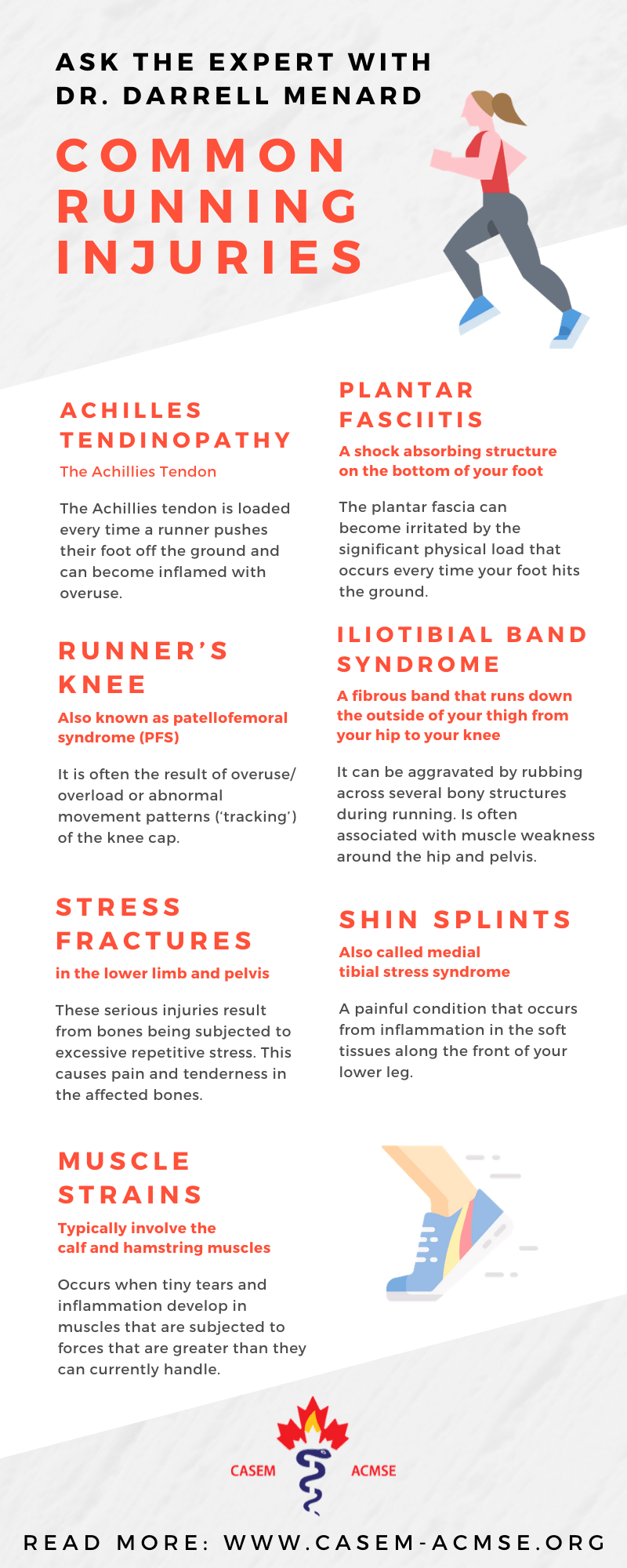Common Running Injuries
Q: I recently started running to improve my fitness and really enjoy it. Typically, I run about six kilometers 3-4 times/wk. To date, I have been injury free but my personnel trainer told me that running has a high injury rate. Is this true and what are the most common running injuries?
– Cautious Carl
A: Dear Cautious Carl:
Running is an amazing sport that is enjoyed by millions of people around the world. Running can be done almost anywhere, with almost no equipment necessary. However, it is a high impact activity involving repetitive movements and these two features increase the risk of injuries. The following are injuries commonly experienced by runners:
- Achilles tendinopathy – the Achilles tendon connects the calf muscles to the back of the heel. The Achillies tendon is loaded every time a runner pushes their foot off the ground and can become inflamed with overuse.
- Plantar fasciitis – the plantar fascia is a shock absorbing structure on the bottom of your foot. Tthe plantar fascia can become irritated by the significant physical load (usually more than twice your body weight) that occurs every time your foot hits the ground.
- Runner’s knee – also known as patellofemoral syndrome (PFS) – results in pain in the region of your knee cap. It is often the result of overuse/ overload or abnormal movement patterns (‘tracking’) of the knee cap.
- Iliotibial band syndrome (ITBS) – is a fibrous band that runs down the outside of your thigh from your hip to your knee. It can be aggravated by rubbing across several bony structures during running and is often associated with muscle weakness around the hip and pelvis.
- Stress fractures in the lower limb and pelvis – these serious injuries result from bones being subjected to excessive repetitive stress. This causes pain and tenderness in the affected bones.
- Shin splints – also called medial tibial stress syndrome – is a painful condition that occurs from inflammation in the soft tissues along the front of your lower leg.
- Muscle strains– typically involve the calf and hamstring muscles and occur when tiny tears and inflammation develop in muscles that are subjected to forces that are greater than they can currently handle.
All these injuries have one thing in common – they result from body tissues being subjected to more stress than they can handle. This is often the result of runners trying to ‘do too much too soon’ and increasing the distance or speed they run too quickly. Failing to give their body adequate time to recover between runs can also contribute.
The bottom line: Running is great way to stay fit, and can be done anywhere, but it does have a relatively high injury rate. Many of these injuries can be avoided by carefully progressing your training, paying attention to discomfort when it first develops and incorporating rest into your training program. If you think you have a running-related injury, consider seeing a sport medicine physician in your community. Train smart and remember “Movement is Medicine!”
Dr. Darrell Menard OMM MD, Dip Sport Med
Dr. Menard is the Surgeon General’s specialist advisor in sports medicine and has worked extensively with athletes from multiple sports. As part of the Strengthening the Forces team he works on injury prevention and promoting active living.
Strengthening the Forces is CAF/DND’s healthy lifestyles promotion program providing expert information, skills and tools for promoting and improving CAF members’ health and well-being.

READ MORE:

